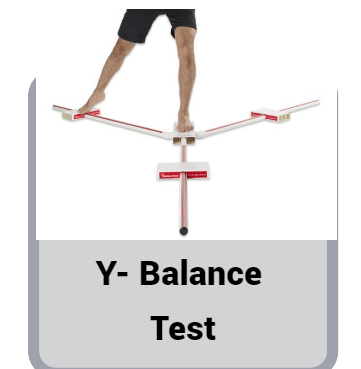Quick Overview
Y Balance Test (YBT) is a dynamic balance test that assesses an individual’s ability to reach in three different directions, ( anterior, posteromedial, and posterolateral) while maintaining balance on a single leg. The YBT is a quick and easy test to perform, and it can be used to assess the fitness level of individuals of all ages.

Table of Contents
Upper Quarter Y Balance Test
The upper quarter Y balance test (UQYBT) is a variation of the YBT which is used to assess dynamic balance in the upper extremity. The UQYBT is performed in the same way as the YBT, but here the individual reaches with their hand instead of their foot.
The UQYBT can be used to assess individuals with shoulder or arm injuries, as well as individuals who participate in sports that require good upper extremity balance.
Lower Quarter Y Balance Test
The lower quarter Y balance test (LQYBT) is the most common variation of the YBT. This test is performed in the same way as the YBT, but here the individual reaches with their foot instead of their hand.
The LQYBT can be used to assess individuals with lower extremity injuries, as well as individuals who participate in sports that require good lower extremity balance.
Read also Drop Arm Test and Sharp Purser Test
Purpose
The purpose of YBT include;
- Assessing dynamic balance in individuals of all ages and fitness levels
- Identifying individuals who may be at risk for injury
- Monitoring the progression of an injury or the effectiveness of treatment
- Evaluating an individual’s readiness to return to sport or activity
Procedure
The YBT is performed as follows:
1- The individual stands on a single leg with their other leg elevated behind them.
2- The individual reaches in the anterior, posteromedial, and posterolateral directions with their free foot.
3- The individual reaches as far as they can without losing their balance.
4- The individual repeats steps 1-3 three times on each leg.
Y Balance Test Scoring
The YBT is scored by measuring the distance that the individual reaches in each direction. The distance is measured from the center of the individual’s stance foot to the farthest point that their free foot reaches.
The average distance reached in each direction is then calculated. Lower scores or significant differences between the left and right sides may indicate potential issues that require attention.
Importance
This test plays a vital role in various fields:
- Injury Prevention: By identifying movement deficits and imbalances, it helps to develop targeted exercise programs to reduce the risk of injury.
- Performance Enhancement: Athletes can use the test results to enhance their functional movement, strength, and agility, thereby improving their overall performance.
- Rehabilitation: Physical therapists utilize the Y Balance Test to design tailored rehabilitation plans for patients recovering from injuries.
- Research: In the realm of sports science and biomechanics, this test provides valuable data for research studies on movement patterns and functional performance.
How to Improve Your Y Balance Test Score
If you want to improve your YBT score, there are a few things you can do:
- Practice the test regularly: The more you practice, the better you will become at maintaining your balance while reaching.
- Strengthen your core muscles: Strong core muscles help to improve your overall balance and stability.
- Improve your flexibility: Good flexibility helps to improve your range of motion, which can help you to reach further.
- Practice exercises that challenge your balance:. This includes exercises such as standing on one leg, walking on a balance beam, and performing yoga poses.
Question
1. What is the Y Balance Test?
It is a dynamic assessment tool designed to evaluate an individual’s balance, strength, and flexibility. It involves reaching movements in multiple directions to assess both upper and lower body functional performance.
2. What Does the Y Balance Test Measure?
The YBT test measures an individual’s balance, stability, strength, and neuromuscular control. It assesses the ability to reach in various directions while maintaining balance, providing insights into movement deficits, imbalances, and potential injury risks.
3. How to Measure Limb Length for the Y Balance Test?
To measure limb length for the Y Balance Test, follow these steps:
1- Sit the individual down with their legs extended.
2- Measure from the anterior superior iliac spine (ASIS) to the medial malleolus (inside ankle bone) of both legs.
3- Record these measurements, as they will be used to calculate the test scores as a percentage of limb length.
4. What is the Name of the Tool Used in a Y Balance Test?
The tool used in this test also known as a Y-shaped balance reach board. This board features three directional lines radiating from a central point, allowing individuals to perform reach movements in different directions.
5. How to Set Up a Y Balance Test?
To set up a Y Balance Test, follow these steps:
1- Place the Y-shaped balance reach board on a flat surface.
2- Ensure the individual stands on one leg with the toes positioned at the central point of the board.
3- The individual will use the opposite foot to reach along each of the three directional lines while maintaining balance.
4- Repeat the test for both legs, recording measurements for each direction.
